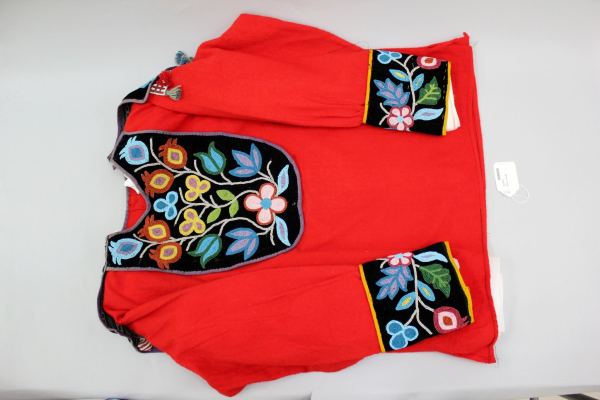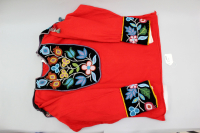Chief George Jacket
Chief George Jacket
Chief George Jacket


Man's shirt. Anishnaabe. Red wool flannel with applied beaded panels worked on black velvet. Panels form a front yoke, cuffs, and a collar and are worked in multi-coloured beads in stylized floral sprays. Beads are threaded on white cotton sewing thread. The edges of the velvet are bound with purple worsted tape. Part of dancing outfit of Chief George (Little Fork Band) Collected by Albert B. Reagan from Bois Fort Reservation, Minnesota, USA.
CMC catalog record.
Read More About This Relative
Rather than scarlet, which refers to a particular dye, the cloth is red wool flannel circulated in 1870s, of low quality. Looks very new. The shirt is made of the width of the fabric - selvage is on both side seams. Worsted wool tape border; black cotton velveteen; two different patterned calico (simple b&w print). Calico very small pattern. Size 11 / 12 seed beads on tabs; size 10 or 11 on panels. Cotton sewing thread; wool yarn; loom work done on linen thread.
1890-1920s. Machine sewn. Panels may be detachable and may have been on previous shirts (shirts are interchangeable). Panels are backed with calico and hand sewn with cotton thread onto the flannel. The body is machine sewn; Hook and eye closing at left shoulder, underneath the bib. Loom work and applique beadwork. Applique is done by filling in lines that are drawn on the velvet using flour and water paste. Tassels -- there seems to be a special one on the end of the panel or perhaps missing on the other end; could have been earlier than rest of garment; RP: recycled parts may be way of carrying older pieces to the present?; LD sometimes given something for regalia work and it may be collection of them if it's a dance shirt; maybe give panels from one generation to the next; might be able to see belt scorching (in Minnesota, loomed sashes tend to be worn) (NOTE: LD: there's only one term for a belt/sash; AL to provide term for "to bind around the girth")
Very common motif for Minnesota beadwork. Tabs look like ones from drum skirt.
Part of Chief George's (Little Fork Band, Fort Frances Agency) dancing outfit.
Calico should be distinguished from another simply called "print" which tended to be bigger (CW).
Collected in 1912 (CMC catalog record)
Provenance
Owned by Chief George, Little Fork Band, Fort Frances Agency, Ontario. Purchased by Reagan in Bois Fort, Minnesota, 1912.
"I purchased Chief George's dancing outfit, tomahawk (which he carried in the dance - it happens to be a Hudson Bay hatchet, decorated in feathers and ribbons), ladle spoon from his soup dish and his carrying sack." (Letter to Edward Sapir, 27 Sept 1912)
Purchased by A. B. Reagan in Bois Fort, Minnesota.
Tercentenary, Pembroke (?)
Harold Burnham, Notes on Textiles in the National Museum collection (unpublished).
About This GRASAC Record













 Knowledge Sharing Platform
Knowledge Sharing Platform

